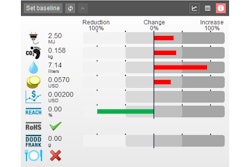San Francisco, Calif.—July 14, 2014—Tradeshift, a business transaction and collaboration platform, announced the findings of a market research effort entitled “ePayables 2014: The Quest.” This independent research report seeks to present a comprehensive, industry-wide view into the quickly evolving nature of accounts payable (AP) functions by drawing on the experience, performance, and perspective of approximately 200 AP, finance and other professionals.
The report notes that the top concerns for accounts payable groups are around reducing invoice processing costs and efficiency. These issues are exacerbated by the fact that 70 percent of invoices within enterprises are still manually received and processed, which adds significant costs and slows down access to critical information.
Though many AP operations are largely stuck using paper-based processes and outdated technologies, the report shows that changes are happening. About 37 percent of respondents said it was very likely that they would move to a largely automated AP process in the next two to three years.
These changes are happening as AP begins to transform its role into a more strategic component of financial operations, focusing on value-adding activities as opposed to administrative tasks. The discussion is no longer whether to automate AP, but when a solution can be deployed and how quickly it can be mastered.
As noted in the report, “The speed of business today requires a different level of engagement and alignment with trading partners than what was once required. Leveraging the collective strength of a supply chain to the benefit of all participants is the hallmark of the agile and progressive businesses who understand that an increasing dependence on third- party partners and suppliers is not just an inevitability, but a pre-condition of success.”
"Best-in-class accounts payable groups show that a high level of performance can be unlocked by leveraging technology,” said Andrew Bartolini, chief research officer, Ardent Partners. “We expect, over the next few years, to see more AP groups initiate technology initiatives that are designed to transform their operations from generally inefficient and clunky functions to more strategic, automated and well-oiled machines that sit at an important business intersection.”
Additional key findings of the study include:
- The average cost to process an invoice is approximately $14.21. The report notes that introducing AP automation can potentially reduce costs by 60 to 80 percent as evidenced by best-in-class enterprises who report costs around $2.42 per invoice.
- Top-performing AP operations are able to process an invoice in approximately 3.7 days whereas it takes others over 17 days.
- Around 55 percent of respondents are planning to implement an e-invoicing solution over the next two years.
Said Christian Lanng, CEO of Tradeshift, “What still confounds me is that, despite advances in payment technology, like contactless on the consumer side, enterprise business payment processes are stuck in the past. Most companies are still using outdated invoicing procedures, such as manually sending out invoices, tracking transactions and keeping a ledger. If you want your company to survive and thrive, you must disrupt outmoded operations in order to adapt to fast-changing needs and remain competitive. This frees up the payments in the pipeline, allowing you to invest in other areas of your company, further propelling your business forward.”














